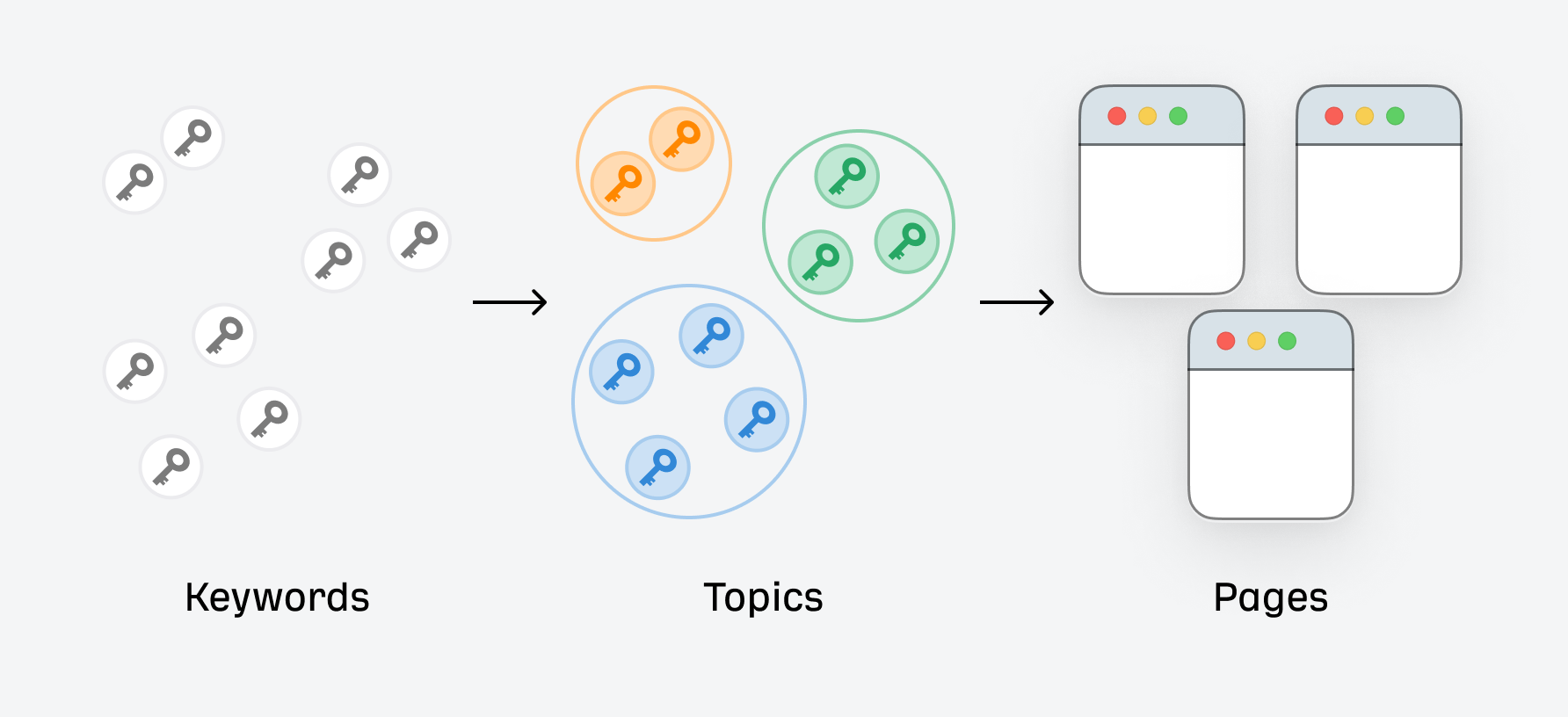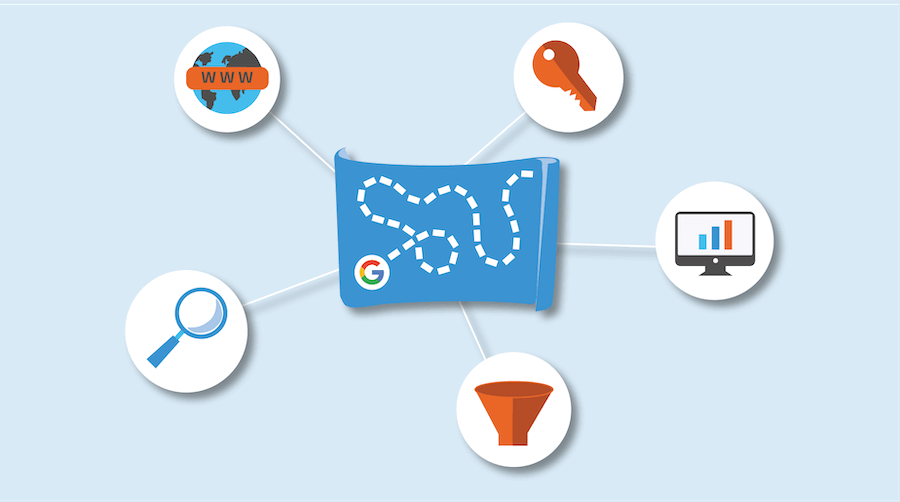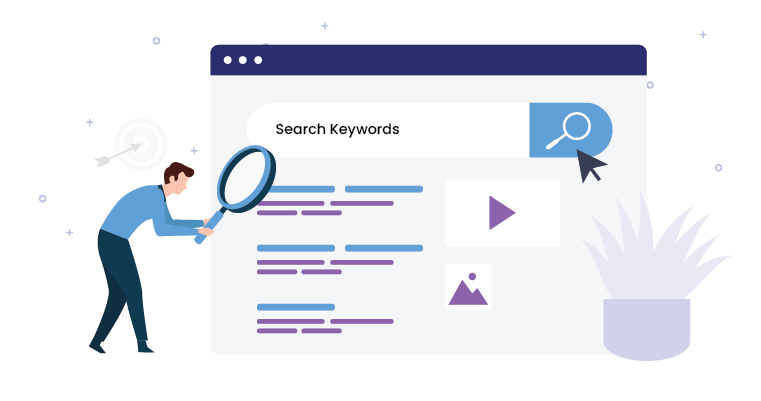As a SaaS company, you know that organic traffic is critical for sustainable growth. One of the most effective ways to drive that traffic is through strategic keyword mapping.
At VH Info, we specialize in helping SaaS businesses like yours build high-quality links and optimize your site structure to rank higher in search results.
In this comprehensive guide, we’ll break down exactly what keyword mapping is, why it matters for SEO, and how you can implement it to supercharge your search rankings.
What is Keyword Mapping?

Keyword mapping is the process of systematically assigning target keywords to specific pages on your website. The goal is to create a logical site structure that aligns with user search intent and is an important part of your search engine optimization (SEO) keyword strategy.
Mapping keywords to URLs helps optimize each page for search queries, an essential digital marketing practice to rank on google search.
Why Keyword Mapping Matters?
Keyword mapping is a foundational SEO strategy that offers several key benefits:
- Improves site organization and navigation
- Prevents keyword cannibalization between pages
- Identifies content gaps and opportunities
- Guides on-page optimization and link-building efforts
- Enhances the user experience by matching intent
Without a keyword map, your site lacks an intentional structure. There are a lot of benefits of keyword mapping. You risk targeting the same keywords on multiple pages or missing out on valuable search opportunities altogether.
Why is Keyword Mapping Important in SEO?

Search engines like Google aim to provide the most relevant results for each query. Keyword mapping helps demonstrate to Google that your pages comprehensively cover a topic and deserve to rank.
When multiple pages target the same keywords, they compete against each other. This keyword cannibalization confuses search engines and dilutes your ranking potential. Mapping keywords to unique pages solves this issue.
Keyword mapping also reveals gaps in your content strategy. You can identify valuable search terms you’re missing and create new pages to target them. This expands your organic reach.
How Does Keyword Mapping Work?

The keyword mapping process involves:
- Conducting keyword research to find relevant keywords and terms
- Grouping keywords into topical clusters
- Assigning clusters to existing pages or planning new ones
- Optimizing pages for their target keywords
- Regularly updating the keyword map as your site evolves
The result is a master document that maps keywords to pages and guides your ongoing SEO efforts.
How to Do Keyword Mapping?

While the specifics may vary, the general process for keyword mapping includes these steps:
- Identity Your Site’s Topic Areas: Start by brainstorming the main topics or categories your site covers. These will form the basis of your keyword map.
- Group Keywords into Topic and Keyword Clusters: Using keyword research tools, identify search terms related to your topics. Group them into clusters based on similarity and search intent. Each cluster will be mapped to an individual page.
- Select the Most Relevant Ideas: Prioritize keyword clusters based on relevance, search volume, and ranking difficulty. Focus on mapping the keywords that have the highest potential value for your business.
- Assign URLs to Pillar Pages and Subpages: Choose a main pillar page to target each broad topic area. Then assign supporting subpages to more specific keyword clusters within that topic. The pillar page should link to the subpages and vice versa.
How To Map Keywords To Pages?
Here’s a step-by-step breakdown of how to map keywords to pages:
- Keyword Research: Use tools like Ahrefs, Semrush, and Google Keyword Planner to research keywords related to your business. Look at search volume, keyword difficulty, and competitor rankings.
- Filter & Group Keywords: Refine your keyword list by filtering out irrelevant terms. Then group the remaining keywords into clusters based on meaning and intent.
- Create Keyword Map: Create a spreadsheet with columns for keywords, search volume, difficulty, page type (existing vs. new), and target URL. Add a row for each keyword cluster.
- Map to Existing URLs & Create New URLs: For each keyword cluster, identify the best existing page to target those terms. If no relevant page exists, plan a new page to create. Add the URLs to your keyword map.
- Optimise & Create Content: Include the mapped keywords naturally into the page titles, headings, meta descriptions, and body content. Ensure the SEO content comprehensively covers the topic. Create new pages as needed.
- Update Regularly: Keyword mapping isn’t a one-time task. Analyze your rankings and traffic regularly, and update your keyword map as you identify new opportunities.
How To Do Keyword Mapping Based on Intent and Ranking Opportunity?
Effective keyword mapping goes beyond just search volume. Analyze the search intent behind each keyword and prioritize terms that match your business goals.
For example, “what is [product” keywords suggest informational intent, while “[product pricing” keywords indicate commercial investigation intent. Map keywords to pages that align with their intent.
Also, assess ranking difficulty using metrics like Ahrefs’ Keyword Difficulty or Semrush’s Keyword Difficulty Percentage. Aim for a balance of high-volume and lower-competition terms.
How to Use Keyword Mapping For On-Page SEO?

Keyword mapping guides three main areas of on-page optimization:
Keyword Optimization
Incorporate exact and partial-match keywords naturally in:
- Page titles and meta descriptions
- H1 and subheadings
- Body content
- Image alt text
- Internal link anchor text
Optimize Meta Tags
Ensure each mapped page has a unique, keyword-rich title tag and meta description that matches search intent. Use modifiers like “best“, “guide“, “checklist“, etc. to capture long-tail variations.
Optimize URL Structure
Include keywords in your page URLs where relevant. Use a logical hierarchy of folders to group related pages. Avoid long, complex URLs.
Do Keyword Mapping For SEO to Rank Higher?
Yes, keyword mapping helps you rank higher by:
- Ensuring each page targets a distinct set of keywords
- Signaling to Google which pages are most important for a topic
- Guiding on-page optimization to better match search intent
- Providing a roadmap for strategic internal linking and site architecture
When combined with quality content, backlinks, and technical SEO, keyword mapping is a powerful way to boost your organic rankings.
Best SEO Keyword Mapping Tools
While you can create a keyword map manually, SEO tools make the process much more efficient.
Some of the best tools for keyword mapping include:
- Ahrefs: Offers extensive keyword data, content gap analysis, and competitor research features. The Content Explorer and Site Audit tools are especially useful for mapping keywords to pages.
- Semrush: Provides keyword data, ranking insights, content templates, and a built-in Keyword Mapper tool. Also includes competitor keyword gap analysis.
- Moz: Has a comprehensive keyword research tool and a Keyword Difficulty metric to assess ranking potential. MozPro includes site crawl and page optimization features.
- AudienceKey: Focuses on keyword clustering and content planning. Helps identify topical gaps and opportunities in your keyword map.
- SE Ranking: Offers an all-in-one platform with keyword research, competitor analysis, page change monitoring, and a keyword rank tracker to measure progress.
How to Use Your Keyword Map Effectively?

A keyword map is only useful if you put it into action. Here’s how to get the most value from your keyword mapping efforts:
- Optimize Pages for Target Keywords: For existing pages in your keyword map, optimize the on-page elements like title tags, headings, and body content to include the mapped keywords. Avoid stuffing keywords unnaturally.
- Fill Content Gaps with New Content: Identify keyword clusters in your map that don’t have a matching URL yet. Create new, comprehensive content optimized for those keywords to capture more organic traffic.
- Use Keyword-Rich Anchor Text: When linking between pages on your site, use descriptive, keyword-rich anchor text based on your keyword map. This helps search engines understand the relationship between pages and spreads link equity.
Why Keyword Mapping Never Stop?
Keyword mapping isn’t a set-it-and-forget-it strategy. Your target keywords will evolve as your business grows and the search landscape changes.
New products, features, and content on your site will require mapping new keywords. Competitors may start targeting your keywords, or entirely new keywords may emerge as search trends shift.
Regularly revisit your keyword map to find new opportunities, assess your rankings, and adapt your targeting. Tools like Ahrefs and Semrush are great for spotting keyword movements over time.
Common Keyword Mapping Pitfalls to Avoid
To get the most out of keyword mapping, watch out for these common mistakes:
- Determine Your Keywords: Don’t just guess which keywords to target. Use real data from keyword research tools to inform your mapping decisions.
- Compile Groups of Keywords: Avoid mapping single keywords to pages. Group keywords into topical clusters for a more comprehensive SEO approach.
- Identify Your Keywords: Don’t try to stuff every keyword variation into your page content. Identify the most important 1-2 keywords for each page and target those naturally.
- Continue to Refine your Keyword Map: Keyword mapping isn’t a one-and-done task. Continuously update and expand your keyword map as your site and the search landscape evolve.
Can You Create Keyword Maps For E-Commerce and Other Large Sites?
Yes, keyword mapping is important for e-commerce and large sites. However, the process can be more complex due to the sheer number of pages and keywords.
Keyword Mapping Tips For E-Commerce and Enterprise Websites
- Prioritize mapping category, subcategory, and product pages first
- Group long-tail keywords based on searcher intent
- Use dynamic keyword insertion for templated pages like product listings
- Leverage site search data to identify keyword trends and gaps
- Automate rank tracking to monitor thousands of keywords efficiently
Keyword Mapping Example

Let’s say you sell project management software. A basic keyword map might look like:
| Keyword Cluster | Search Volume | Difficulty | URL |
|---|---|---|---|
| Project management software | 1,000 | 50 | /project-management-software |
| Best project management tools | 800 | 60 | /best-project-management-tools |
| Project management features | 500 | 30 | /project-management-features |
| Project management pricing | 400 | 40 | /pricing |
The pillar page would broadly target “project management software“, while the subpages cover more specific related topics. Each page would be optimized for its assigned keyword cluster.
To get best results from keyword mapping, try going as in-depth as possible.
SEO Keyword Mapping Best Practices
To recap, here are the SEO best practices for effective keyword mapping:
- Group keywords by topic and search intent
- Map keywords to the most relevant pages
- Optimize each page for its target keywords
- Use keyword-rich internal link anchor text
- Regularly update your keyword map based on data
- Avoid keyword stuffing and cannibalization
- Leverage tools to scale keyword mapping for large sites
FAQ’s:
How Can A Keyword Map Help Me Create Content?
A keyword map helps you identify content opportunities to target valuable search terms. By mapping keywords to pages, you create a content roadmap aligned with actual search demand.
What’s The Difference Between Keyword Mapping and Keyword Stuffing?
Keyword mapping is a strategic process of assigning keywords to specific pages. Keyword stuffing is the spammy practice of excessively repeating keywords on a page. Proper keyword mapping naturally incorporates keywords without stuffing.
How Do Keyword Maps Affect Content Marketing?
Keyword maps inform your content strategy by revealing which topics and subtopics to cover. They help align your content calendar with search trends and business goals.
Is Keyword Mapping Different For Local SEO?
The core process is the same, but for local SEO, your keyword map should include geo-specific terms like “near me” and “[city name“. Map these to location pages or local landing pages.
Conclusion
Keyword mapping is a powerful SEO strategy for any SaaS business looking to drive more organic traffic and rankings. By methodically assigning keywords to specific pages, you can optimize your site structure, inform your content strategy, and better align with searcher intent.
While the process takes effort, keyword mapping tools like Ahrefs and Semrush can streamline the workflow. And the potential payoff in increased search visibility is well worth it.
At VH Info, we specialize in helping SaaS companies like yours build authoritative backlinks and rank higher in search results. Our expert team can guide you through the keyword mapping process and optimize your site for maximum organic growth.
Ready to get started with keyword mapping? Contact VH Info today to learn more about our SEO services and how we can help you crush your traffic goals.



